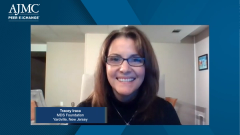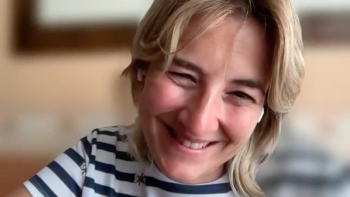
Educating Patients and Caregivers on MDS Subtypes
Practical perspectives on how to communicate MDS subclassifications with affected patients and caregivers.
Episodes in this series

Transcript:
Bruce Feinberg, DO: Tracey, at the patient level, when you’re dealing with the health literacy of the general population in developing your materials, how do you do it? How do you explain the different types of disease that make up the umbrella of MDS [myelodysplastic syndromes]?
Tracey Iraca: It’s not an easy task. We want patients to understand low risk vs high risk at the very least, and even that’s troublesome sometimes. But the MDS Alliance is a coalition of MDS groups that the MDS Foundation is a part of. For World Awareness Day in October, they did animations for subtypes. They created little characters and did animations and released them through social media to explain every subtype. They were really successful. We tried to make sure, keeping health literacy in mind, that we’re at a sixth to eighth grade level of understanding. It’s still complicated. Even the original script was complicated for me. I asked them to simplify it even further. It’s not easy, but we’re up to the task.
Bruce Feinberg, DO: Ryan, at your level at the patient’s bedside, the doctor just explained everything and they have deer eyes. They’re in shock and have no idea what they were just told. It’s often up to a pharmacist on the team or maybe an advanced practice provider to sit down and have that conversation. What are you doing in terms of trying to break it down in a way they can understand?
Ryan Haumschild, PharmD, MS, MBA: That’s a great question, because it’s very confusing. Even patients who they do their homework, when they go on to cancer.net, they will see the WHO [World Health Organization] scale that might use outdated terms like refractory, to Amer’s point. We’re changing from that. By the way, you heard it first on AJMC® Peer Exchange: we’re looking to switch to new nomenclature to make MDS easier to understand. But when we meet with that patient, we have to boil it down to the physiology: “Here’s what’s happening with your red blood cells. Here’s what’s happening with your treatment. There are different classifications.” It’s good for patients to know that.
Bruce, you mentioned this. When patients show up to their primary care provider, if they get referred—maybe they go to Florida for the winter and are being followed up and treated there—they need to understand whether their MDS with ring sideroblasts or what type of MDS they have. They can understand what their unique genetic makeup is, how it’s being treated, how it’s being managed, and the goals of care. Based on those criteria, there are certain treatments we’re looking for. Tracey said it really well. That’s knowing whether they’re low or high risk and what our goal is. Are we trying to move away from red blood cell infusions? Are we trying to move away from certain treatments? That’s what we spend a lot of time doing.
Bruce, I know we’ll get into this a little later on, but we create some standardized follow-up time periods with these patients so that we’re looking for these symptoms and remind them that. If they ever come to the infusion center or get a drug from the specialty pharmacy, we reeducate them on the same material. You’d be surprised how many patients didn’t absorb a thing when they initially heard their diagnosis from the provider, but that reemphasize and reeducation with the materials we give them makes a big difference in their engagement in the care strategy.
Bruce Feinberg, DO: Amer, when we get down to what the patient can understand and take away, do you also go back to low, intermediate, and high risk? What are the critical points you want them to walk away with?
Amer Zeidan, MBBS, MHS: That’s a very good question. As a general rule, I try to give information according to the level of patient. As was mentioned, some patients are super sophisticated. They have dug every piece of literature about MDS when they come to you, and there are other patients who might not necessarily be interested in knowing all the details. They just want to know what you’re going to recommend for them. It’s a question of adapting the information to the patient.
But what matters to the patient at the end is the overall long picture in terms of expectation, because that affects the management. Boiling it down to lower risk vs higher risk is very important. The idea of intermediate-risk MDS is always very challenging, even for us physicians, because even if it’s intermediate risk, you’re ultimately going to have to decide whether you’re treating this patient as lower risk or higher risk. I generally try to move away from calling anything intermediate, although it’s something that’s part of the risk certifications and the label for some of the agents.
Bruce Feinberg, DO: Let’s drill down further and separate the low-risk from the high-risk elements. Amer, take it away.
Amer Zeidan, MBBS, MHS: When you look at the factors we discussed—the number of blasts, blood transfusions, blood counts, and karyotypic abnormalities—you add in different points and then you come up with a risk score. That risk score is going to fall in place in whatever tool you’re using. We mentioned the IPSS [International Prognostic Scoring System]. Then we have the revised IPSS, which was introduced in 2012. And now we have the molecular IPSS that has been in the making for some time and was presented at ASH [American Society of Hematology Annual Meeting] in December. This could potentially become a standard of care over the next 2 years. That will also add in the genetic information that until now we didn’t have a formal way to incorporate into the decision or these risk-prognostication tools. Once you make your determination, you counsel the patient about what they expect and basically what the goal of the treatment is, which is a big part of the discussion.
Transcript edited for clarity.
Newsletter
Stay ahead of policy, cost, and value—subscribe to AJMC for expert insights at the intersection of clinical care and health economics.

































































